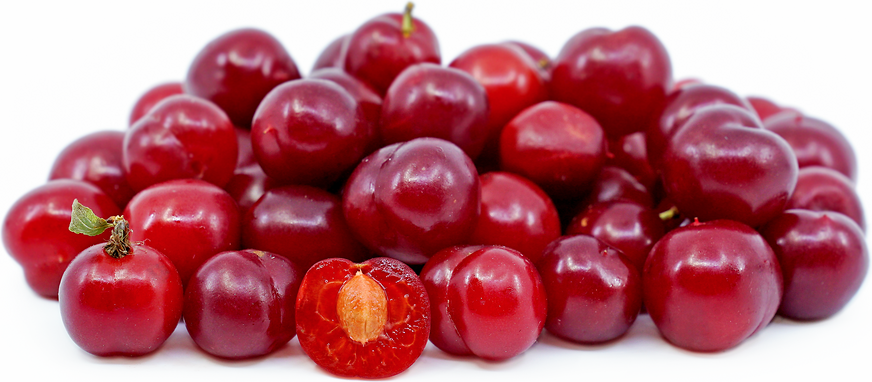


Nanking Cherries
Estimated Inventory, bskt : 0
Description/Taste
Nanking cherries grow on a medium-sized shrub that reaches no more than 2 and a half meters tall. The small red fruits, or drupes, grow in clusters on short stems. The clusters of fruit are nestled in among the leaves, spaced out at intervals along the branches. Nanking cherries are quite small, measuring one to 2 centimeters in diameter (about the size of a blueberry). Their pale pink to bright cherry red skin is shiny and smooth, and the pulp is juicy. Each fruit contains one seed, much like other cherries. Nanking cherries are sweet and tart.
Seasons/Availability
Nanking cherries are available in the late spring and throughout the summer months.
Current Facts
The Nanking cherry, botanically known as Prunus tomentosa, is a popular shrub that is grown for both its appearance and its fruit. In the spring, the dense shrub is covered in white to pale pink flowers. Most cultivars produce red fruit; however, a white variety does exist. Often referred to as Nanking Bush cherry, the fruiting shrub is cultivated in eastern Russia and is popular among home gardeners and permaculturalists in the United States.
Nutritional Value
Nanking cherries, like sour cherry varieties, contains rich amounts of vitamins A and C, as well as calcium and iron. The tart cherries contain anthocyanin, the compound that gives the fruit its rouge hue. This phytochemical gives Nanking cherries powerful antioxidant and anti-inflammatory properties. The fruit can also help lower uric acid levels in the blood, which can result in gout.
Applications
Nanking cherries are eaten fresh or used to make pies, jams and jellies. Pitting the small cherries can be time consuming, so it may be easier to cook the cherries in a small amount of water, allowing the skins to burst and release the pit. Strain the liquid to remove the pits and skin remnants, leaving the liquid for making jelly or to use as a concentrate for beverages. Remove the pits and dry Nanking cherries to preserve the fruit. Add whole pitted Nanking cherries to sauces, either sweet or savory, like a barbeque sauce. Use Nanking cherries to flavor vinegar or pickle unripe fruits. The small cherry variety is highly perishable and need to be consumed within a day or two.
Ethnic/Cultural Info
Nanking cherries are considered more manageable than common cherry trees due to their size and plentiful fruiting nature. They are highly regarded as a good, edible landscape variety, and make an appearance at the Dr. George Washington Carver Edible Park near downtown Asheville, North Carolina. The park was established as the ‘Bountiful Cities Project’ in 1997 and later renamed for the famed botanist and inventor in 2000. The edible park is host to over 40 varieties of mature, productive, fruit and nut trees.
Geography/History
Nanking cherries are native to many areas of Southeastern Asia, China, Tibet and the Himalayas. They were cultivated for hundreds of years in Asia before being introduces to England in 1870 and then to the United States in 1882. At one time, there may have been a large number of named varieties, but many have been lost over the last 100 years. In the United States, Nanking cherries are more common in the northeast, mid-Atlantic region, and eastward towards the Grand Lakes region. In Russia, the Nanking cherry has been hybridized with other Prunus varieties to create more commercially viable fruit. Nanking cherry plants must be planted in pairs, so the one can pollinate the other, otherwise the plant will not fruit. When planted from seed, Nanking cherries can be highly variable; the best quality fruit comes from rootstock cuttings. Once established, it can withstand high winds, drought and cold temperatures, though they do not grow well in overly hot or humid climates. The small berries are not commercially cultivated due to their delicate and highly perishable nature. Nanking cherries can be found in home gardens and through small farms at local farmer’s markets in temperate climates.
Recipe Ideas
Recipes that include Nanking Cherries. One
| Deanna's Daughter |
|
Nanking Cherry Jelly |
| Midwest Living |
|
Nanking Cherry Jelly |
| Getty Stewart |
|
Nanking Cherry Liqueur |
| Tarladalal |
|
Nanking Cherry and Almond Sorbet |
| Fruit Share |
|
Nanking Cherry Juice and Jam |




